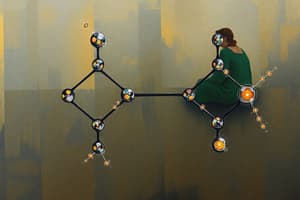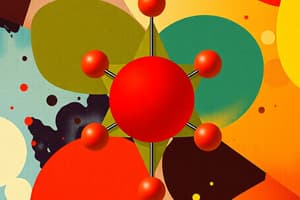Podcast
Questions and Answers
How many bonding electrons does an atom of magnesium have?
How many bonding electrons does an atom of magnesium have?
- 4
- 3
- 2 (correct)
- 5
What substance could be an ionic?
What substance could be an ionic?
- 1770°C
- 35°C (correct)
- 2630°C
- 2220°C
Why does argon exist as stable, unbonded atoms?
Why does argon exist as stable, unbonded atoms?
Argon has a full valence shell with 8 electrons (octet rule).
What molecule has a linear shape around its central atom?
What molecule has a linear shape around its central atom?
What fifth period element has 2 lone pairs and 2 bonding electron in its valence level?
What fifth period element has 2 lone pairs and 2 bonding electron in its valence level?
Which molecule possesses a triple covalent bond?
Which molecule possesses a triple covalent bond?
What is the shape around the central atom in a molecule of H2CO?
What is the shape around the central atom in a molecule of H2CO?
Identify the following bonds as ionic, polar covalent, slightly polar covalent or ionic. Use appropriate notation to indicate bond dipoles. K-F
Identify the following bonds as ionic, polar covalent, slightly polar covalent or ionic. Use appropriate notation to indicate bond dipoles. K-F
Which compound can dissolve in water?
Which compound can dissolve in water?
Water, H2O, has a considerably higher boiling temperature than hydrogen sulfide, H2S. How can this be explained?
Water, H2O, has a considerably higher boiling temperature than hydrogen sulfide, H2S. How can this be explained?
What force of attraction is characterized by the formation of temporary dipoles or instantaneous and induced dipoles?
What force of attraction is characterized by the formation of temporary dipoles or instantaneous and induced dipoles?
What chemical bond arises when two atoms simultaneously attract a pair of valence electrons?
What chemical bond arises when two atoms simultaneously attract a pair of valence electrons?
What substance will have the highest boiling point? CI4, CuZn, KI, SiS2
What substance will have the highest boiling point? CI4, CuZn, KI, SiS2
What describes the bonding in NaCl?
What describes the bonding in NaCl?
What substance will NOT conduct electricity? Ba(l) Ba(s) BaCl2(l) BaCl2(s)
What substance will NOT conduct electricity? Ba(l) Ba(s) BaCl2(l) BaCl2(s)
What substance will have the strongest London Dispersion forces?
What substance will have the strongest London Dispersion forces?
Which substance exists at room temperature as a solid crystal lattice consisting of uncountable cations and anions?
Which substance exists at room temperature as a solid crystal lattice consisting of uncountable cations and anions?
Which substance has the lowest boiling point?
Which substance has the lowest boiling point?
An unknown substance was found to be very hard, had a very high melting point, did not conduct electricity in the solid or molten state and was insoluble in water. What is the identity of the unknown solid substance?
An unknown substance was found to be very hard, had a very high melting point, did not conduct electricity in the solid or molten state and was insoluble in water. What is the identity of the unknown solid substance?
Draw a correct electron dot diagram for CH3COOH(2)
Draw a correct electron dot diagram for CH3COOH(2)
Provide a detailed analysis of the intermolecular forces present in each of these substances and predict which of them has the higher boiling point. (a) CH3PH2 and CH3Cl
Provide a detailed analysis of the intermolecular forces present in each of these substances and predict which of them has the higher boiling point. (a) CH3PH2 and CH3Cl
Provide a detailed analysis of the intermolecular forces present in each of these substances and predict which of them has the higher boiling point. (b) CH3OH and C5H12
Provide a detailed analysis of the intermolecular forces present in each of these substances and predict which of them has the higher boiling point. (b) CH3OH and C5H12
Complete the following table: a) CH3NH2 Electron dot: Name the Shape: VSEPR diagram (include bond dipole if polar): Polarity:
Complete the following table: a) CH3NH2 Electron dot: Name the Shape: VSEPR diagram (include bond dipole if polar): Polarity:
Explain using a theory of metallic bonding why tin strips are malleable.
Explain using a theory of metallic bonding why tin strips are malleable.
Explain using a theory of ionic bonding why calcium chloride is brittle and shatters under force.
Explain using a theory of ionic bonding why calcium chloride is brittle and shatters under force.
Based on a relative force analysis, arrange the following substances in order of decreasing boiling point (highest to lowest) Explain why? Cn (diamond), Mg, C4H10, C4H9OH, C4H8(OH)2, C4H9Br, MgS, CH4
Based on a relative force analysis, arrange the following substances in order of decreasing boiling point (highest to lowest) Explain why? Cn (diamond), Mg, C4H10, C4H9OH, C4H8(OH)2, C4H9Br, MgS, CH4
What substance will have the highest boiling point?
What substance will have the highest boiling point?
What substance will NOT conduct electricity?
What substance will NOT conduct electricity?
Provide a detailed analysis of the intermolecular forces present in each of these substances and predict which of them has the higher boiling point. (a) CH3PH2 and CH3Cl (b) CH3OH and C5H12
Provide a detailed analysis of the intermolecular forces present in each of these substances and predict which of them has the higher boiling point. (a) CH3PH2 and CH3Cl (b) CH3OH and C5H12
Complete the following table: a) CH3NH2 Electron dot: Name the Shape: VSEPR diagram (include bond dipole if polar): Polarity: b) CH3OH Electron Dot: Name the Shape: VSEPR diagram (include bond dipole if polar): Polarity:
Complete the following table: a) CH3NH2 Electron dot: Name the Shape: VSEPR diagram (include bond dipole if polar): Polarity: b) CH3OH Electron Dot: Name the Shape: VSEPR diagram (include bond dipole if polar): Polarity:
Which of the following compounds would be soluble in a solvent such as carbon tetrachloride, CCl4? Explain why?.
Which of the following compounds would be soluble in a solvent such as carbon tetrachloride, CCl4? Explain why?.
Which substance, either an ionic compound or alloy would you expect to be easily shaped into a nail? Explain your choice?
Which substance, either an ionic compound or alloy would you expect to be easily shaped into a nail? Explain your choice?
Why are metals excellent conductors of electrical current? Explain.
Why are metals excellent conductors of electrical current? Explain.
Why ionic compounds are solids at room temperature? Explain.
Why ionic compounds are solids at room temperature? Explain.
Sketch an electron sea model for the silver (90%) and copper (10%).
Sketch an electron sea model for the silver (90%) and copper (10%).
Flashcards
Bonding electrons in Magnesium
Bonding electrons in Magnesium
Magnesium has 2 valence electrons that participate in bonding.
Ionic Substance Properties
Ionic Substance Properties
Ionic compounds have high melting points, conduct electricity in the liquid state, and are usually hard and brittle.
Water-soluble substance
Water-soluble substance
Substances that can dissolve in water, like ionic compounds, acids, and bases.
Argon's stability
Argon's stability
Signup and view all the flashcards
Linear molecule shape
Linear molecule shape
Signup and view all the flashcards
Triple covalent bond
Triple covalent bond
Signup and view all the flashcards
Fifth period element with 2 lone pairs
Fifth period element with 2 lone pairs
Signup and view all the flashcards
Shape of H2CO
Shape of H2CO
Signup and view all the flashcards
K-F bond type
K-F bond type
Signup and view all the flashcards
Cl-Cl bond type
Cl-Cl bond type
Signup and view all the flashcards
Si-P bond type
Si-P bond type
Signup and view all the flashcards
P-Cl bond type
P-Cl bond type
Signup and view all the flashcards
Solubility in water
Solubility in water
Signup and view all the flashcards
Higher boiling point of water than hydrogen sulfide
Higher boiling point of water than hydrogen sulfide
Signup and view all the flashcards
London Dispersion Forces
London Dispersion Forces
Signup and view all the flashcards
Covalent bond
Covalent bond
Signup and view all the flashcards
Highest boiling point substance
Highest boiling point substance
Signup and view all the flashcards
NaCl bonding
NaCl bonding
Signup and view all the flashcards
Non-conducting substance
Non-conducting substance
Signup and view all the flashcards
Strongest London Dispersion Forces
Strongest London Dispersion Forces
Signup and view all the flashcards
Crystal lattice
Crystal lattice
Signup and view all the flashcards
Study Notes
Review Sheet Unit 2 Test Chem 2202
- Magnesium atoms have 2 bonding electrons
- Substances with high boiling points may be ionic or polar covalent.
- Poor electrical conductivity in a solid state indicates that the substance may be ionic or covalent.
- Substances that conduct electricity in both liquid and solid states are usually metallic.
- Argon exists as individual atoms due to lack of need for electron sharing.
- Linear shaped molecules contain a central atom with two identical atoms at the ends, and no other atoms attached to the central atom.
- Triple covalent bonds are formed by sharing three pairs of electrons between two atoms (e.g., in C2H2).
- A fifth period element with two lone pairs and two bonding electron pairs in its valence level could be sulfur (or Selenium, Tellurium, Polonium but sulfur is likely based on the period).
- The shape around the central carbon atom in H2CO is trigonal planar.
- Potassium Fluoride (KF) is an ionic bond, chlorine-chlorine (Cl-Cl) is a nonpolar covalent bond, Silicon-Phosphorus (Si-P) is a polar covalent bond, and Phosphorus-Chlorine (P-Cl) is a polar covalent bond.
- Compounds soluble in water usually have polar covalent bonds.
- Water has a higher boiling point than hydrogen sulfide because water molecules form stronger hydrogen bonds.
- Temporary/instantaneous and induced dipoles are a type of intermolecular force.
- A chemical bond occurs when two atoms share one or more pairs of electrons.
- Substances with high boiling points usually have stronger intermolecular forces, such as higher molecular weight leading to stronger London Dispersion forces, hydrogen bonds, or dipole-dipole interactions.
- Sodium Chloride (NaCl) has ionic bonding.
- Substances that do not conduct electricity in either liquid or solid state are likely nonpolar or poor conductors.
- Substances with stronger London Dispersion forces have higher boiling points (e.g., larger molecules).
- Ionic compounds are crystalline solids composed of cations and anions.
- Electron dot diagrams represent valence electrons.
- Metallic bonding involves a "sea of electrons" surrounding positive metal ions.
- Due to the nature of ionic bonds, calcium chloride (and similar) is brittle and shatters under force.
- Intermolecular forces influence boiling points, with stronger interactions leading to higher boiling points.
- Solubility depends on the polarity of the solute and the solvent. like dissolves like.
- Substances with high melting points and hardness are generally ionic compounds which are difficult to shape .
Additional Questions and Concepts
- Analyze intermolecular forces in different substances (e.g., CH₃PH₂, CH₃Cl, CH₃OH, and C₅H₁₂) to predict boiling points.
- Determine the solubility of different substances in a solvent like carbon tetrachloride (CCl₄) based on polarity.
- Identify the substance with the lowest boiling point from a list of substances.
- Understand the properties of substances based on the nature of their bonding.
- Explain metallic bonding and its impact on malleability of metals.
- Explain ionic bonding and its connection to brittleness in ionic compounds.
Studying That Suits You
Use AI to generate personalized quizzes and flashcards to suit your learning preferences.




